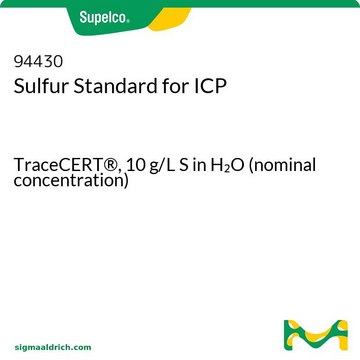1.00318
Hydrochloric acid
30%, SUPRAPUR®
Synonym(e):
Salzsäure -Lösung, Chlorwasserstoffsäure
About This Item
Empfohlene Produkte
Produktbezeichnung
Salzsäurelösung, 30% Suprapur®
Qualität
for inorganic trace analysis
Qualitätsniveau
Agentur
suitable for EPA 200.7
suitable for EPA 200.8
Dampfdruck
21.8 hPa ( 20 °C)
Assay
30%
Form
liquid
pH-Wert
<1 (20 °C, 300 g/L in H2O)
bp
85 °C/1013 hPa
mp (Schmelzpunkt)
-50 °C
Dichte
1.15 g/cm3 at 20 °C
Lagertemp.
15-25°C
SMILES String
Cl
InChI
1S/ClH/h1H
InChIKey
VEXZGXHMUGYJMC-UHFFFAOYSA-N
Suchen Sie nach ähnlichen Produkten? Aufrufen Leitfaden zum Produktvergleich
Verwandte Kategorien
Anwendung
- Optimization of enantioselective high-performance liquid chromatography-tandem mass spectrometry method for the quantitative determination of 3,4-methylenedioxy-methamphetamine (MDMA) and its phase-1 metabolites in human biological fluids: Diese Studie beleuchtet die Verwendung einer Salzsäurelösung im Probenvorbereitungsprozess zur präzisen analytischen Bestimmung von MDMA und seinen Metaboliten mittels HPLC-MS/MS (Sprega et al., 2024).
- Coprecipitation as a One-Step Se Separation for Determination of Isotope Ratios Completed with Revised Uncertainty Evaluation: In dieser Forschungsarbeit wird Salzsäurelösung in der Kopräzipitationsmethode zur Trennung von Selenisotopen verwendet, wodurch eine Verbesserung der analytischen Genauigkeit und Zuverlässigkeit erzielt wird (Karasiński et al., 2024).
- Removal of Methyl Red from Aqueous Solution Using Biochar Derived from Fennel Seeds: In diesem Artikel wird die Verwendung von Salzsäurelösung bei der Herstellung von Biokohle zur effektiven Entfernung von Methylrotfarbstoff aus Wasser untersucht, was in der Umweltsanierung von Bedeutung ist (Paluch et al., 2023).
- Tyrosine Amino Acid as a Foulant for the Heterogeneous Anion Exchange Membrane: Die Forschungsarbeit befasst sich mit der Verwendung von Salzsäurelösung bei der Untersuchung von Tyrosinaminosäure-Fouling auf Anionenaustauschmembranen, was Einblicke in Mechanismen des Foulings von Membranen ermöglicht (Kharina und Eliseeva, 2023).
Hinweis zur Analyse
Farbe: ≤ 10 Hazen
Bromid (Br): ≤ 10 ppm
Freies Chlor (Cl): ≤ 300 ppb
Phosphat (PO₄): ≤ 10 ppb
Sulfat (SO₄): ≤ 300 ppb
Sulfit (SO₃): ≤ 500 ppb
Ag (Silber): ≤ 1,0 ppb
Al (Aluminium): ≤ 1,0 ppb
As (Arsen): ≤ 1,0 ppb
Au (Gold): ≤ 1,0 ppb
Ba (Barium): ≤ 1,0 ppb
Be (Beryllium): ≤ 1,0 ppb
Bi (Bismut): ≤ 1,0 ppb
Ca (Calcium): ≤ 5,0 ppb
Cd (Cadmium): ≤ 0,5 ppb
Co (Cobalt): ≤ 1,0 ppb
Cr (Chrom): ≤ 1,0 ppb
Cu (Kupfer): ≤ 1,0 ppb
Fe (Eisen): ≤ 5,0 ppb
Ga (Gallium): ≤ 0,5 ppb
Ge (Germanium): ≤ 10,0 ppb
Hg (Quecksilber): ≤ 2,0 ppb
In (Indium): ≤ 0,5 ppb
K (Kalium): ≤ 10,0 ppb
Li (Lithium): ≤ 0,5 ppb
Mg (Magnesium): ≤ 2,0 ppb
Mn (Mangan): ≤ 0,5 ppb
Mo (Molybdän): ≤ 0,5 ppb
NH₄ (Ammonium): ≤ 500 ppb
Na (Natrium): ≤ 10,0 ppb
Ni (Nickel): ≤ 1,0 ppb
Pb (Blei): ≤ 0,5 ppb
Pt (Platin): ≤ 0,5 ppb
Sb (Antimon): ≤ 0,5 ppb
Sn (Zinn): ≤ 1,0 ppb
Sr (Strontium): ≤ 0,5 ppb
Ti (Titan): ≤ 1,0 ppb
Tl (Thallium): ≤ 0,5 ppb
V (Vanadium): ≤ 1,0 ppb
Zn (Zink): ≤ 1,0 ppb
Zr (Zirconium): ≤ 0,5 ppb
Glührückstand (als Sulfat): ≤ 2 ppm
Die Chargenwerte unterliegen den in diesem Konzentrationsbereich
unvermeidlichen Schwankungen.
Rechtliche Hinweise
Signalwort
Danger
H-Sätze
Gefahreneinstufungen
Eye Dam. 1 - Met. Corr. 1 - Skin Corr. 1B - STOT SE 3
Zielorgane
Respiratory system
Lagerklassenschlüssel
8B - Non-combustible, corrosive hazardous materials
WGK
WGK 1
Flammpunkt (°F)
Not applicable
Flammpunkt (°C)
Not applicable
Analysenzertifikate (COA)
Suchen Sie nach Analysenzertifikate (COA), indem Sie die Lot-/Chargennummer des Produkts eingeben. Lot- und Chargennummern sind auf dem Produktetikett hinter den Wörtern ‘Lot’ oder ‘Batch’ (Lot oder Charge) zu finden.
Besitzen Sie dieses Produkt bereits?
In der Dokumentenbibliothek finden Sie die Dokumentation zu den Produkten, die Sie kürzlich erworben haben.
Kunden haben sich ebenfalls angesehen
Verwandter Inhalt
Atomic spectroscopy techniques like AAS, AES, ICP-OES, and ICP-MS identify and quantify elemental composition in samples.
Atomic spectroscopy uses the energy absorbed or emitted by electrons to identify and quantify the elemental composition of a sample. It includes various analytical techniques, such as AAS, AES, FAA, GFAA, ICP-OES, ICP-MS and XRF.
In der Atomspektroskopie wird die von Elektronen absorbierte oder emittierte Energie verwendet, um die Elementzusammensetzung einer Probe zu identifizieren und zu quantifizieren. Sie umfasst verschiedene Analysetechniken, wie z.B. AAS, AES, FAA, GFAA, ICP-OES, ICP-MS und XRF.
Unser Team von Wissenschaftlern verfügt über Erfahrung in allen Forschungsbereichen einschließlich Life Science, Materialwissenschaften, chemischer Synthese, Chromatographie, Analytik und vielen mehr..
Setzen Sie sich mit dem technischen Dienst in Verbindung.




